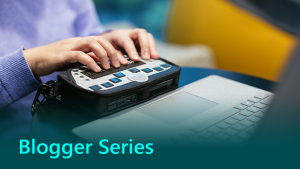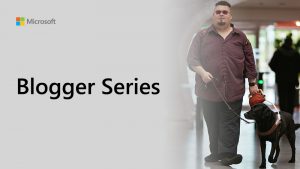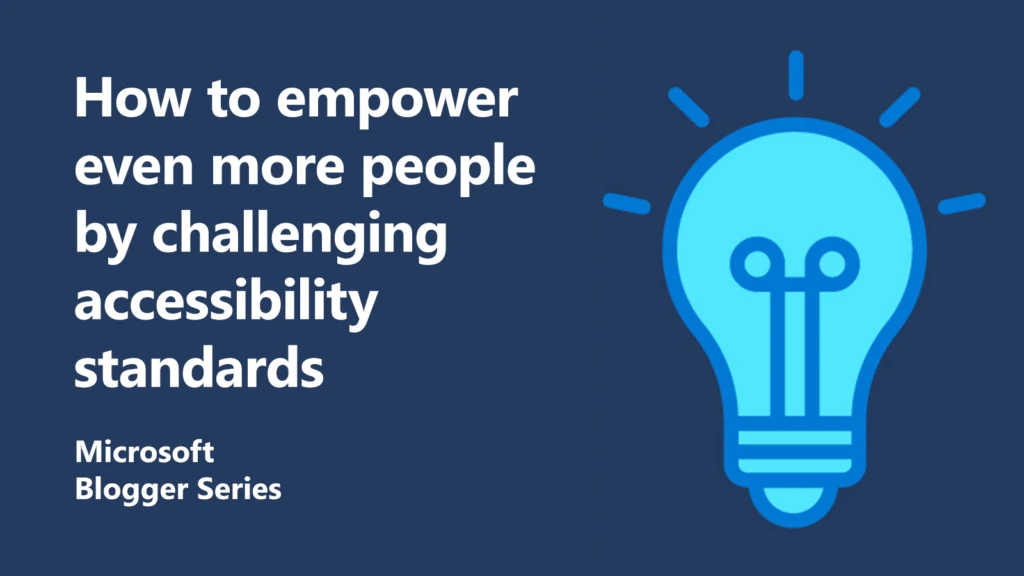
How to empower even more people by challenging accessibility standards
Our mission is to empower every person and every organisation to achieve more, and we can’t achieve that without accessibility being at the heart of what we do. This doesn’t end with the products and services we offer. It extends to our workplace culture. We weave accessibility into the fabric of our company. From hiring, to creating inclusive marketing, and offering resources to help your organisations to do the same.
We’ve always had accessibility standards ensuring we use closed captions and subtitles but we needed to think beyond that. Like many organisations, our accessibility journey is ongoing. It adapts as we learn and get feedback from our employees, partners, and customers. As Storytelling & Digital Destinations Lead, I continually challenge myself and my team to reimagine our websites, pushing to create great experiences that everyone can access.
Through our AI for Good cohort, we were made aware that for over 70 million Deaf people globally, their first and preferred language is sign language. Sign languages are structured differently from spoken and written language. As a result, some Deaf people have difficulties understanding content in written form. Many rely on friends and family to access the information they need. For example, getting a COVID vaccination is not a simple task when booking and follow-up information is in written text and healthcare staff are wearing facemasks (reducing the ability to lipread).
Despite our focus on accessibility and ensuring all content has subtitles and closed captions, this identified that our content was still inaccessible to a broad group of people.
“BSL is not the same as spoken English or written English, says Tim Scannell, Signly ambassador. “A lot of companies say English is good enough, because they think that Deaf people can understand English like a first language. We’re trying to show that the Deaf grassroots BSL community don’t necessarily understand English well.”
As part of the Deaf BSL community, Tim and Signly have been researching into the impact of the lack of BSL services. “They [BSL users] would always talk about having to bother somebody who is hearing that they knew.” Tim says. For some, this may be the children of Deaf adults, which then changes their relationships and increases stress and anxiety for both. “It also took Deaf people sometimes long time to understand.” For example, if a hearing customer had an issue with their bank, they could go into the branch, or call and get it sorted quickly. “A Deaf customer, however, will go into the branch and the bank would give them written information to read, or they [the bank] wouldn’t know about booking an interpreter or very rarely that would happen. But most don’t know how. They just apologise and say they couldn’t. A Deaf person just wants better communication.”
Learning about Signly
Technology has the power to help everyone. Therefore, it’s clear that we need to make sure that no one gets left behind. That’s why at Microsoft, we’re always looking at ways we can improve accessibility.
We were introduced to Signly when they became part of our AI for Good programme. Instantly, I knew they’d be a key partner to help us further our inclusion goals.
What do Signly do? Their technology translates written text to sign language. It removes this barrier, making content more accessible and is all run on Azure.
“A lot of firms think about just providing the typical accessibility features and think it’s okay, and it’s always because of the wrong perception that Deaf people are okay with English,” says Tim. “If people only think about the options they’ve set up. That’s not going to work. They need to think sometimes outside of the box.”
And Signly thinks innovatively. Signly allows users to self-serve, view or request sign language translations on webpages. The AI for Good programme helped Signly scale their app. Lloyds Bank became the first UK organisation to offer a translation website in British Sign Language.
“Signly covers the fixed information you have on a website so that you make less calls to need an interpreter,” says Tim.
With only around 1000 interpreters in the UK, it’s important we use technology to assist them in their roles while empowering BSL users. Both the World Federation of the Deaf (WFD) and the World Association of Sign Language Interpreters (WASLI) express how machine learning or AI signing avatars should not be used when the information being delivered is live, complex or of significant importance to the lives of Deaf citizens. Signly helps free up BSL interpreters to focus on those moments, while giving BSL users equal access to the information when they need it.
Improving access for everyone with sign language
The Microsoft Apprenticeship Network was built to help connect apprentices and organisations together. To bridge a digital skills gap, the UK needs over three million people in tech careers by 2025. Apprentices are key to this.
At the same time, we need to ensure that our new talent is diverse and inclusive. According to the NHS, people who are Deaf or experience hearing loss are more likely to be unemployed. And in employment, 74 percent surveyed felt that their employment opportunities were limited because of their hearing loss. This means we’re missing out on diverse perspectives, building new talent and driving inclusive innovation. We’re also missing out on the potential economic output. If we don’t address these employment rates by 2031 the UK economy will lose £38.6 billion per year.
The low code tech behind the solution
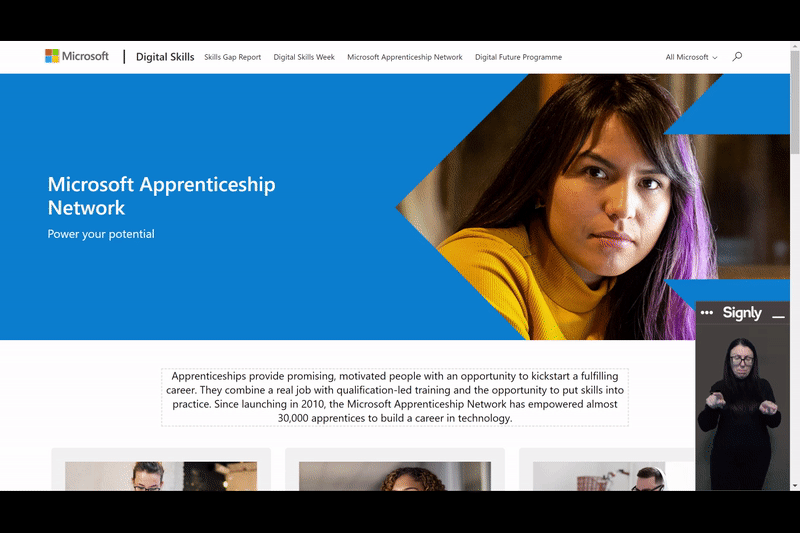
The beauty behind Signly is its simplicity. As a low code solution, it can be easily added to any website. You can translate the pages like we did. So, when you launch you are automatically accessible for everyone. The service also works on demand. Users can request websites to be translated when they need it.
“We use Azure to create a ‘Signing Studio,’” explains Mark Applin, Signly CEO. “It grabs the English straight from the website and fires it straight into the teleprompter for the Deaf translator working from a home studio.”
From there, the video goes back to Azure, and straight onto the web page. And when you update your website, a notification is automatically sent to Signly to update that section. This means all your users are getting the right information at the right time.
The BSL user experience
When Tim showed the website to other BSL users, he said they were amazed and relieved. As one Signly user said: “Wow. That’s wonderful, that’s really beautiful. I’ve had a problem with all kinds of things, whether it’s doctors or banking and nobody will help me with the English. And I don’t know any of that in English… I have to go to Citizen’s Advice. There’s just barriers everywhere. All the companies just won’t help you.”
“People were getting emotional just to see something in their language.”
– Tim Scannell, Signly ambassador
The future of our accessibility journey with sign language
Working with Signly has shown me the massive opportunity it has in democratising access to everyone. Our values are right there on our website. We aim to help everyone achieve more. And we want to not just talk the talk but to walk the walk. Signly helps us achieve this goal. This is the start of a journey. This pilot is a good first step to see how we can scale the technology across other websites. In the future we can even perhaps scale it to our partners and customers.
“I think with Microsoft being such a massive leader, it could have a huge impact on so many other firms and organisations and what can be done. Every website should have sign language content. It makes deaf people feel accepted,” says Tim.
Another Signly user agrees with Tim. “It [BSL on websites] would be a massive benefit. Less stressed, I’d know how to communicate. I wouldn’t constantly have to ask what does this mean, what does that mean. It would give us equality. I can learn at the same time.”
How Signly could transform other industries
It’s also a great opportunity for the public sector to deliver important information to BSL users. For example, the NHS could use it to provide fixed information around vaccinations, as suggested by a Signly user: “They [The NHS] send me a leaflet about the vaccine, and I said, ‘I just can’t read it’. I’ve not had any information about the vaccine. I keep saying ‘where is the interpreter?’ They’re all wearing masks and I can’t lip read them. If I had a bad reaction, I don’t know what to look out for.”
Media companies can also leverage the technology, to provide more equitable access to news and content. “You miss things on the news…The BBC website should have sign language on the news [page]. And the NHS,” adds a BSL user.
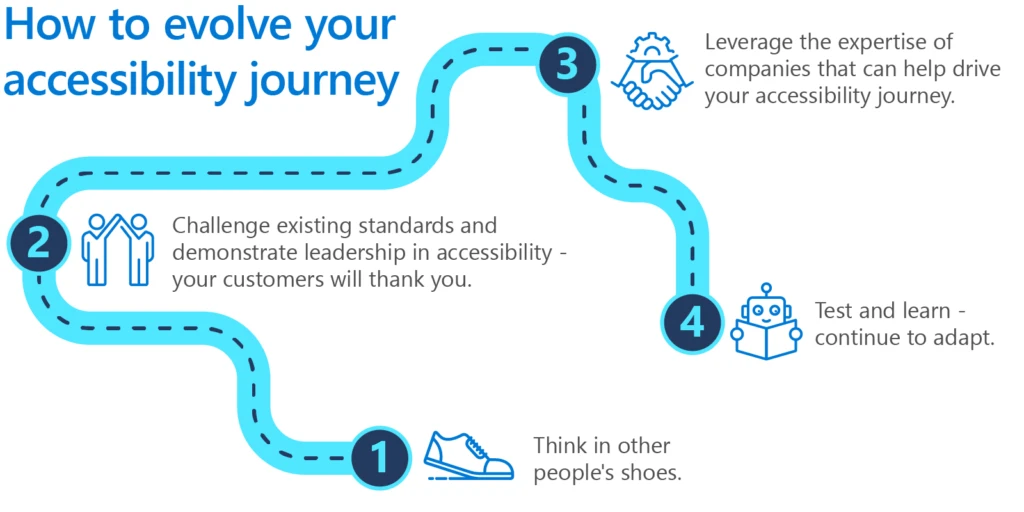
Your accessibility journey will be constantly evolving as you learn. It’s important to remember that implementing inclusive designs in your services and products is not a ‘one and done’ job. It’s a continuous process that you must update and approach in new ways. And working with companies like Signly, you can easily scale out these innovations. This endeavour is a stepping stone for us at Microsoft. It’s one we are proud of and hope to expand on.
Find out more
Help Signly and take part in their social impact research
Resources to empower your development teams
Learn the basics of web accessibility
About the author
 Great stories demand heroes, emotions, and insight. As Storytelling & Digital Destinations Lead at Microsoft UK, Victoria Oakes places these principles at the heart of Microsoft UK’s content output. In this role, she drives to unify messaging and content across Microsoft using insights at the heart. Through her passion for engaging copy, visual storytelling, and data-driven insights, she truly cares about content being useful, interesting and easy to digest. As a philanthropy advocate, Victoria strongly believes in using technology for social impact, strengthening empowerment and inclusion for all and environmental sustainability.
Great stories demand heroes, emotions, and insight. As Storytelling & Digital Destinations Lead at Microsoft UK, Victoria Oakes places these principles at the heart of Microsoft UK’s content output. In this role, she drives to unify messaging and content across Microsoft using insights at the heart. Through her passion for engaging copy, visual storytelling, and data-driven insights, she truly cares about content being useful, interesting and easy to digest. As a philanthropy advocate, Victoria strongly believes in using technology for social impact, strengthening empowerment and inclusion for all and environmental sustainability.


